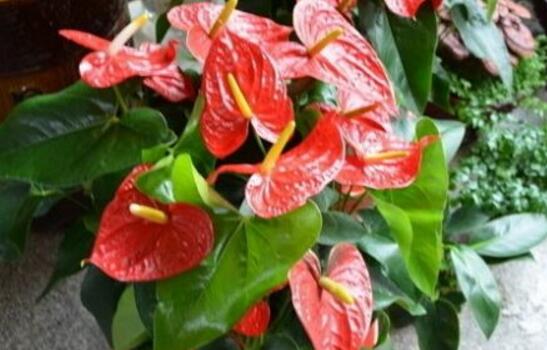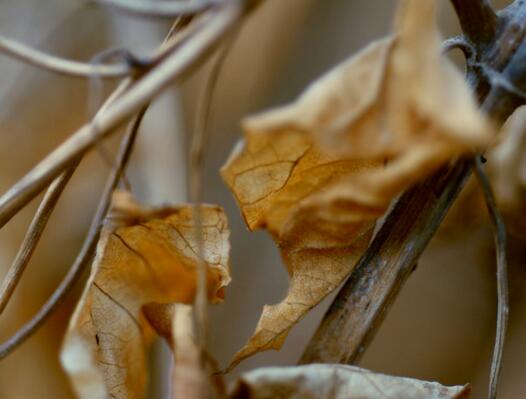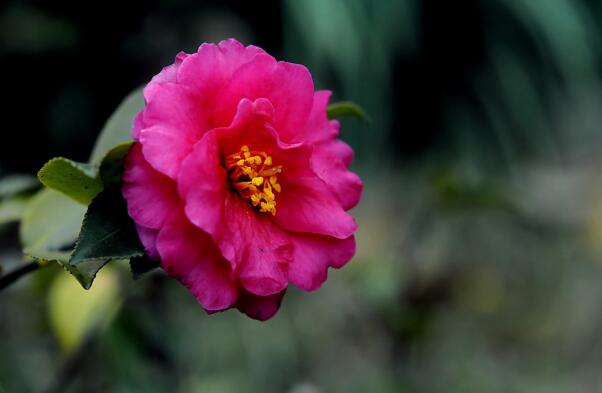What to do with the growing insects of Anthurium andraeanum? prevention and control of common diseases and insect pests of Anthurium andraeanum / 8 methods
When planting Anthurium andraeanum, what I am most afraid of is diseases and insect pests, because many people do not know about diseases and insect pests, let alone how to control them, so they often don't know what to do. What if Anthurium andraeanum grows? Today, I will introduce in detail the common pest control methods of Anthurium andraeanum.
What if the Anthurium andraeanum grows worms?
Plant insect growth is an abnormal phenomenon, but what if Anthurium andraeanum grows? It is necessary to determine the species of pests, and then deal with them according to the common pest control of Anthurium andraeanum, and the pests that often appear on Anthurium andraeanum are red spiders, nematodes, scale insects and thrips.
1. Red spider

Symptoms: tiny red worms appear on the leaves, it is difficult to see with the naked eye, the leaves and flowers will gradually fade and turn white.
Treatment method: brush away the red spider with a brush, and spray drugs for prevention and control, generally using permethrin, permethrin, triclofenac and other agents to dilute and spray. If the pest is more serious, the branches and leaves need to be cut off and burned, usually pay attention to the temperature is not too high.
2. Nematodes
Symptoms: there are gallbladder-like lumps in the roots and brown spots, which may cause root rot if not treated in time.
Treatment method: in the prevention and control of common diseases and insect pests of Anthurium andraeanum, nematodes are more common, which generally need to be prevented before planting, such as disinfecting the soil, etc., and when there are insect pests, you can use to buy pesticides in the florist to irrigate the roots of the plant.
3. Scale insects
Symptoms: Brown spots appear on the leaves, in severe cases, the leaves will be covered with pests, the growth of the plant is slow, and the leaves may even turn yellow.
Treatment: put Anthurium andraeanum in a well-ventilated place with a temperature of about 25 degrees, spray with fungicides, usually pay attention to appropriate amount of watering, moderate humidity and temperature of the environment.
4. Thrips
Symptoms: the leaves appear white, yellow or black thrips, they attach to the leaves to absorb plant juice or fungi, grow in June-September, the leaves will gradually turn black.
Treatment method: it can be sprayed with a special agent. If it is more serious, it is necessary to cut off all the branches to avoid infection of other branches and leaves.
Control of common diseases and insect pests of Anthurium andraeanum
1. Leaf blight
Symptoms: generally occur in July-October, the onset of the disease starts from the leaf edge, leaf tip, initially for reddish brown to grayish brown irregular spots, and then connected into a large area of withered spots, the final dry area may account for more than half of the leaf surface.
Treatment method: ① thoroughly removed the diseased fallen leaves in autumn and burned them centrally; ② knew the breeding methods and matters needing attention of Anthurium andraeanum, used fertile soil with good drainage, paid attention to fertilization and watering; ③ was sprayed with 1000 times of carbendazim wettable powder solution.
2. Root rot
Symptoms: root rot, leaves yellowing and then withering, the reason is that the root rot caused by fungi, resulting in reduced ability of the root to absorb water and nutrients, resulting in the death of the whole plant, which usually occurs in March-May.
Treatment method: disinfect the soil when ① is planted, and disinfect the soil with carbendazim, which can avoid a lot of diseases; when ② occurs, it can be irrigated with metachlorin or copper preparation; ③ should pay attention to normal maintenance and keep the environment moderate.
3. Anthrax
Symptoms: leaf veins form round brown disease spots, which gradually link to form large brown disease spots, and finally the whole plant dries up and then dies.
Treatment method: ① was sprayed with carbendan and mancozeb, diluted with clear water, once every 7 days, usually 2-3 times; ② cleaned up diseased leaves or plants, strengthened maintenance and management, and paid attention to environmental hygiene.
4. Leaf spot
Symptoms: the disease spot on the leaf is round, then expands into irregular shape, and produces wheel lines, the disease spot changes from reddish brown to dark brown, and the center is grayish brown. The stems and petioles are brown and elongated.
Treatment: ① cut off the diseased tissue and burn it centrally to prevent other plants from being infected; ② is sprayed with 80% mancozeb diluted into 600x solution, or it can be sprayed with 50g carbendan diluted into 500x solution.
The prevention and control of common diseases and insect pests of Anthurium andraeanum in potted plants sometimes appear the phenomena of premature senescence, deformity, adhesion, fissures, vitrification and blue spots, which are mostly physiological diseases caused by fertilization, improper management of soil and air humidity or varieties. The prevention method is to improve cultivation management, reasonable fertilization and proper ventilation. The main diseases and insect pests of potted Anthurium andraeanum are bacterial wilt, leaf spot, root rot, Alternaria, Stylophora, nematodes, red spiders, aphids, Lepidoptera pests, whitefly, shell insects, snails and so on. Anthracnose is one of the common diseases of Anthurium andraeanum. The pathogen is Alternaria or Alternaria. The former is characterized by the formation of round brown disease spots along the veins of the leaves, and then the disease spots are linked together to form large disease spots with brown edges, and the disease finally dries up. The latter is similar to the former, there are black bad hairs on the conidial disk, and it will cause flower rot and form black necrotic spots on the inflorescence of the fleshy spike. High humidity is the main cause of the disease. The prevention and control methods are chemical control and strengthening cultivation management, always ventilating and transparent, avoiding watering or air-conditioning condensate splashing on the leaves, and removing diseased leaves in time. Red spider damage symptoms: mainly make leaves and flowers fade, affecting the commercial nature of leaves and flowers. The damage can be controlled by spraying at the initial stage, and the control agents are: dicofol, Pandike, omethoate and permethrin, etc. A bacterial disease caused by Xanthomonas aeruginosa that infects leaves and fleshy spikes. In the early stage of the disease, the leaves formed watery, translucent irregular spots, and then turned black, with a bright yellow edge and greenness around the spot. The pathogen can cause systematic infection, such as yellowing of old leaves, breaking of petiole and yellowing of vascular bundles. The method of prevention and control is to strengthen cultivation management, supplemented by chemical control, timely removal of diseased plant residues and burning. In the process of cultivation and management, man-made wounds and the use of ammonium nitrogen fertilizer should be reduced as much as possible. Generally, agricultural streptomycin or neophytomycin is sprayed at the initial stage of the disease. The symptom of bacterial leaf spot disease is that on leaves and flowers, water stains can be seen on the back of leaves and flowers in the early stage, and brown spots appear on the leaf margin in the later stage, accompanied by yellow halo. The other is that the bacterial infection begins on the stem and rapidly extends to the whole plant through the microtubule bundle. At the initial stage, it can be found that the color of the new leaf is dark, because the microtubule bundle is blocked by bacteria, which hinders the flow of water and nutrition in the body, so that the leaf color is dim and the leaves turn yellow. in a short time, this type of infection will lead to pedicel and leaf shedding from the plant, rapid decay of the growth point and concentrated outflow of bacteria. There is no specific cure for bacterial diseases, mainly based on prevention: environmental prevention: strengthening the control of greenhouse temperature (the ideal breeding condition of bacteria is about 30 degrees), sanitary environment and the flow of personnel and working tools in production areas. Fertilizer prevention: try not to use high NH4 nitrogen fertilizer in plant growth. Go to or isolate the diseased plant. Leaf blight nematode is caused by nematode infection of the genus nematode, mainly infecting roots and leaves. The disease is characterized by the formation of necrotic spots or brown spots along the veins, the root is enlarged, and finally the whole leaf dries up. The main methods of prevention and control are to strengthen seedling quarantine, select robust seedlings and do a good job in the disinfection of cultivation substrate. What are the common diseases and insect pests of Anthurium andraeanum? Prevention and control techniques of common diseases and insect pests of Anthurium andraeanum
Recently, the editor found that many flower growers were consulting about the cultivation of Anthurium andraeanum in the background, summed up and found that there were the most diseases and insect pests of Anthurium andraeanum. The following editor brings you the prevention and control techniques of common leaf and flower diseases and insect pests of Anthurium andraeanum. For reference!
1 bacterial leaf blight
The leaves can be sprayed with 1000 times of neophytomycin or 5000 times of allicin, 4000 times of 72% streptomycin sulfate or 1200 times of kuikuning. The above drugs were used once every 5 to 7 days, and the effect of rotation was better.
2 bacterial rot
Select 1000-fold solution of neophytomycin or sterilized into 1000-fold solution or agricultural streptomycin 4000-fold solution or Tianwei 3 3500-fold solution or Ningnanmycin 800-fold solution or 1000-fold solution of ningnanmycin or thiazolone 500-fold solution or oxytetracycline 3000-fold solution.
3 fungal anthracnose
It can be controlled with 1000 times of chlorothalonil or 1000 times of methyl topiramate or 2000 times of propiconazole or 2000 times of Baogong wettable powder or 50 times of Baogong wettable powder, 1000 times of carbendazim wettable powder, 3000 times of carbolin wettable powder, 3000 times of high water dispersible granules, 300 times of 25% bromofenitrile EC or 2000 times of Shibaoke. Any of the above chemicals were controlled to be sprayed once in 10 days.
4 fungal black spot
It can be prevented and treated with 10% high 3000-fold solution or 70% methyl topiramate 1000-fold solution or 250g/L Kailun 3000-fold solution.
5 fungal gray mold
The tissue culture seedlings were sprayed with the water-soluble powder of 60% Fangmaibao No. 2 700 times 800 times immediately after transplanting. You can choose 36% thiophanate methyl suspension 500 times 600 times solution, 65% methyl carbendazim wettable powder 1000 times 1500 times solution, 50% carbendazim wettable powder 900times solution, 50% propofol wettable powder 1500 times solution, 50% Sukeling wettable powder 1500 times solution, 65% thiocarbamate wettable powder 1000 times or 60% Baitai 2500 times or 10% Shigao 3000 times or 25% Shibaoke 2000 times.
6 virus disease
It can be controlled with 1.8% avermectin 2000 times or 25% Aktai 4000 times or 4% Bomectin 200 times.
7 leaf-eating pests
This kind of pests mainly include night moths, bridge insects and other Lepidoptera pests. You can choose 20% diflubenzuron suspension 3000-6000 times, butyl ether urea or indenyl 15% hit suspension for prevention and control.
8 integrated prevention and control measures of diseases and insect pests in Anthurium andraeanum leaves
In addition to the above-mentioned chemical prevention and control of Anthurium andraeanum leaf flower diseases and insect pests, we should also pay attention to the comprehensive control from the following aspects.
8.1 strengthen the temperature, humidity and light control of the greenhouse.
The optimum growth temperature of Anthurium andraeanum is 20 ℃ ~ 28 ℃, the highest temperature should not exceed 35 ℃, and the freezing injury may occur when the lowest temperature is lower than 10 ℃. The optimum air relative humidity is 75%-80%, not less than 50%.
Keeping high air humidity in the cultivation environment is the key to the successful cultivation of Anthurium andraeanum. Temperature and humidity should be controlled throughout the year, and plants should be kept dry. It should be cultivated under proper shade throughout the year, and should be properly shaded in spring, summer and autumn, especially in summer.
8.2 strengthen the management of water and fertilizer
Irrigation water should be disinfected as much as possible, and drip irrigation should be used in combination with nutrient solution. At the same time, pay attention to the leaf surface of non-sticky water, in order to reduce the growth of bacteria. Reduce the amount of ammonium nitrate during fertilization, which can reduce the nutrition of bacterial growth and development. The pH of culture medium should be kept at about 5.5.
8.3 strict management of planting area
Strict quarantine and the use of plants or tissues carrying pathogenic microorganisms is prohibited. In order to strengthen sanitary measures, set up a disinfection pool at the entrance of the planting area, we must wash hands with disinfectant, strengthen the disinfection management of working tools, disinfect clothes and shoes, etc., and at the same time strengthen personnel management. minimize personnel replacement and mobility. The plant, tissue and matrix of diseases and insect pests should be found and removed in time, and then put into airtight plastic bags and taken out of the park for destruction.
8.4 promote biological control and timely chemical control
Try to choose bionic agents such as urea and antibiotic pesticides to avoid the use of chemical pesticides. Anthurium andraeanum is relatively sensitive to copper preparations and some organophosphorus pesticides, so chemical pesticides with strong pollution and sensitivity to plants should be avoided as far as possible in the selection of chemical control.
The above are the prevention and control measures of common diseases and insect pests of Anthurium andraeanum. Friends of florists come and learn. You are welcome to put forward more experiences and methods to communicate with other florists!
- Prev

What about lilac worms? disease and pest control of clove flowers / 2 insect pests and 3 diseases
In the process of lilac culture, if the method is wrong, diseases and insect pests are easy to occur, which will not only destroy the beauty of lilac, but also cause the phenomenon of lilac death. What about the lilac worm? How to control the diseases and insect pests of lilac? Next, the editor will take you to learn about it.
- Next

What about the growth of tea plum leaves? pest control of tea plum / 4 insect pests and 3 diseases
As a combination of camellias and plum blossoms, the beauty of Camellia is beyond doubt. Its beautiful leaves, gorgeous colors and charming fragrance are all beloved by people. However, for some reasons, tea plum will grow worms and get sick, thus seriously affecting the ornamental, what about the tea plum leaf worms?
Related
- Fuxing push coffee new agricultural production and marketing class: lack of small-scale processing plants
- Jujube rice field leisure farm deep ploughing Yilan for five years to create a space for organic food and play
- Nongyu Farm-A trial of organic papaya for brave women with advanced technology
- Four points for attention in the prevention and control of diseases and insect pests of edible fungi
- How to add nutrient solution to Edible Fungi
- Is there any good way to control edible fungus mites?
- Open Inoculation Technology of Edible Fungi
- Is there any clever way to use fertilizer for edible fungus in winter?
- What agents are used to kill the pathogens of edible fungi in the mushroom shed?
- Rapid drying of Edible Fungi

